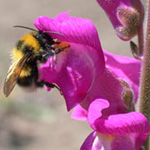Norwich, United Kingdom
August 18, 2006Roses are
red, violets are blue, but why aren't snapdragons orange?
Norwich scientists from the John
Innes Centre (JIC) and the
University of East Anglia (UEA) in collaboration with the
Université Paul Sabatier
(Toulouse, France) have developed a pioneering computer
modelling technique that tracks the evolution of flower colour
in snapdragon (Antirrhinum). Their research, published
today in the prestigious journal
Science, shows how
flower colour has evolved in wild populations of these plants in
the Pyrenees.
 In
the wild, only the plants with the most attractive flower
colours are able to reproduce and thrive because the insects
that pollinate them prefer certain colours. The bees that
pollinate snapdragon find magenta and yellow flowers the most
attractive; they do not find colours such as orange attractive
and so snapdragons of this colour would not flourish in the wild
due to lack of pollination. Scientists already know that natural
colour variation is controlled by three genes. For this study
the researchers wanted to understand how plants producing
magenta or yellow flowers could evolve from a common ancestor
without producing in-between non-attractive flower colours such
as orange. In
the wild, only the plants with the most attractive flower
colours are able to reproduce and thrive because the insects
that pollinate them prefer certain colours. The bees that
pollinate snapdragon find magenta and yellow flowers the most
attractive; they do not find colours such as orange attractive
and so snapdragons of this colour would not flourish in the wild
due to lack of pollination. Scientists already know that natural
colour variation is controlled by three genes. For this study
the researchers wanted to understand how plants producing
magenta or yellow flowers could evolve from a common ancestor
without producing in-between non-attractive flower colours such
as orange.
"This is a totally different
way of looking at evolution and could lead to a better
understanding of the rules that govern biodiversity" explains
Coen, "If we can grasp how snapdragon genes interact in their
natural habitat, it may help us in the future to better preserve
genetic diversity".
The team led by Enrico Coen
(JIC) and Andrew Bangham (UEA) combined molecular, genetic and
computational approaches to analyse flower colour variation in
natural populations of snapdragon.
"We now understand how these
plants can evolve to produce different colours whilst staying
attractive to pollinating insects – we've found that colour can
vary naturally but stays within defined limits" states Enrico
Coen. But if pollinators prefer certain coloured flowers, why
aren't all flowers the same colour? "We still do not know
precisely why flower colours should vary in the first place,"
says Coen, "it could be due to random genetic changes, or
alternatively there could be an evolutionary advantage for
certain colours in different environments".
The researchers are now
applying this new way of modelling evolution to other
characteristics, allowing them to identify how apparently
distinct traits are linked.
BACKGROUND
- Natural colour variation
in snapdragon is controlled by three genes: the genes called
ROSEA and ELUTA affect the intensity and pattern of the
magenta pigment anthocyanin and thirdly the SULFUREA gene
affects the distribution of the yellow aurone pigment.
- Using a traditional model,
a plot of evolutionary fitness for this study appears to
have two peaks: one at the magenta end of the colour
spectrum and a second peak at the yellow end, with a trough
in the middle representing non-attractive intermediate
colours such as orange. As a result, for a plant to evolve
from producing magenta flowers to yellow ones it would first
have to pass through the trough and produce non-attractive
orange flowers before developing yellow ones. By using a
more complex model using higher dimensions, the scientists
are able to trace the evolutionary path that links these two
apparently distinct colour attributes.
- This research was funded
using core strategic grants from the BBSRC.
The JIC, Norwich, UK is an
independent, world-leading research centre in plant and
microbial sciences with over 800 staff. JIC carries out high
quality fundamental, strategic and applied research to
understand how plants and microbes work at the molecular,
cellular and genetic levels. The JIC also trains scientists and
students, collaborates with many other research laboratories and
communicates its science to end-users and the general public.
The JIC is grant-aided by the Biotechnology and Biological
Sciences Research Council.
The University of East
Anglia (UEA) is an internationally renowned, research-led
University with over 13,000 students. UEA is known for its
pioneering and collaborative approach to research, bringing
together academics from different disciplines to create
innovative research groups. The School of Computing Sciences
Computational Biology group is committed to bringing the power
of computational science to biology. The latest Research
Assessment Exercise (2001) confirmed the breadth and depth of
UEA's research excellence through the achievement of the top 5*
or 5 ratings in eleven subject areas, with staff inclusion rates
in the top 10% across the board.
(Photo by Annabel Whibley)
|